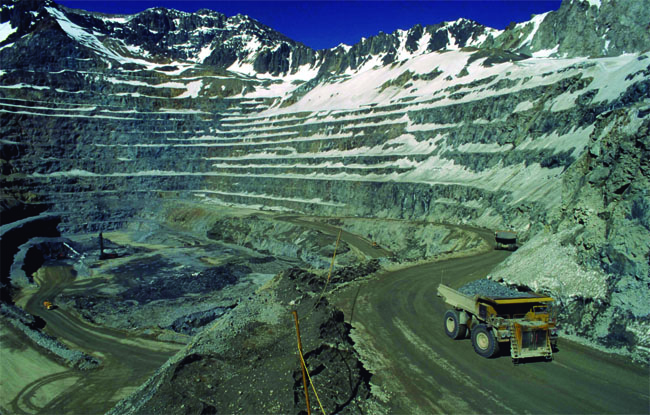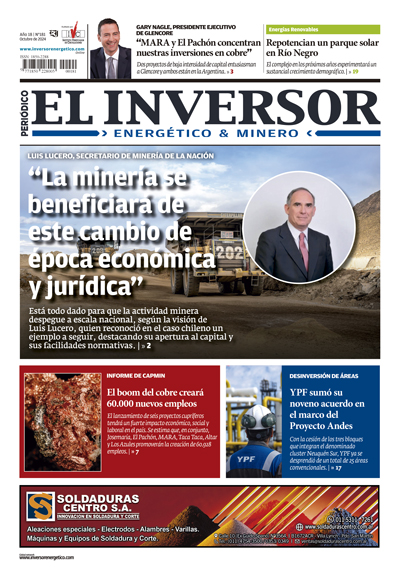No products in the cart.
15 mining projects promising investments for US$ 30,000 million while awaiting for better conditions
A small group of initiatives have not announced their construction start-up yet, but they are on the waiting list. They range from smaller mines, up to megaprojects such as Pachón and Taca Taca. But they are waiting for a substantial improvement in business climate.
With different progress degrees, in a spectrum including exploration projects and those which have already approached feasibility studies, Argentina has 15 mining initiatives that could stimulate investment for US$ 30,000 million between 2015 and 2020.
Figures come from a survey conducted among mining provinces by El Inversor Energético & Minero. These new ventures, have not yet announced their construction start-up, but if they meet the progress plan they could become real in the mid-term.
The group is made up of mega projects demanding sidereal investment, such as Xstrata Copper’s Pachón, which is preparing its Environmental Impact Statement (EIS) and is at feasibility stage, which will cost, once launched, around US$ 6,000 million, as well as high potential exploratory prospects, such as Taguas, in San Juan, or Taca Taca, in Salta, which achieving an appropriate level of reserves and accomplishing their construction, would stimulate investment, as a whole, for more than US$ 7,000 million.
«There are about 25 advanced projects, which starting-off, would ensure the activity development in the mid and long term,» said Julio Ríos Gómez, president of Gemera, the entity that brings together exploring mining companies in Argentina. Clearly, by size, the largest deposits are in the north of Cuyo and in the NOA region (Northwest of Argentina).
In San Juan, for instance, Goldfield continues exploring Taguas, a gold, silver and copper reservoir. It is an initiative which, however, still needs to gather several thousand of drilled meters to quantify its mineralization areas in detail, but in some years it could stimulate, when construction starts, about US$ 3,000 million.
More advanced, although still at an exploratory stage, is Los Azules and Altar status, two copper projects in the south of San Juan. The former, owned by Minera Andes, boosted the exploratory drilling of 26,000 meters in its last campaign launched in October. Its operations setup would require about US$ 3,500 million, a similar figure that would be required by Altar, owned by Stillwater Resources.
Clearly, both initiatives realization, like many others at starting point, demand a series of issues. For example: projects’ external financing, which is the greatest challenge considering restrained international markets, especially investment funds and stock markets. And regulatory and legal warranties nationally and in the provinces.
The exchange rate issue is not less important. Throughout 2012, operating mining companies in the country could not transfer dividends to their headquarters due to the corporate version of the exchange restrictions installed by Cristina Kirchner’s administration.
After tough negotiations, the Banco Central allowed them to slowly move forward regarding this operation during January this year. But since February 1st, new rules from AFIP (tax collecting agency) complicated this kind of procedures once again.
In the South
«Financial markets hit by the European crisis and the slowdown in Asia are expected to improve in the second half of the year,» explained a trader. As for the country’s regulatory situation, the greatest breakdowns occur in southern districts. Patagonia is marked by an unhappy peculiarity: it is one of the regions where the most advanced mining projects are –some in a position to begin exploitation– which, due to legal problems, are kept standby.
This is the case of, for instance, Pan American project, Navidad, which plans production of one of the largest silver deposits in the world, but is suspended due to Chubut’s law 5001, which does not allow this activity in the province Central Plateau. This issue not only affects private investors. The CNEA, Comisión Nacional de Energía Atómica (National Atomic Energy Commission) has been postponing for years Cerro Solo exploitation, the most important uranium reservoir in the country, for the same reason.
Still, there are initiatives with green light to move forward. Such as Lindero, owned by Canadian Goldrock, which foresees gold mining in the Puna, Salta; Lomada de Leiva, owned by Patagonia Gold –one of the few mining companies with local equity participation, represented by the Miguens-Bemberg group–, which moves towards gold production in Santa Cruz; and Cerro Moro, owned by Yamana gold, which plans to start the construction of a metalliferous mine in the same province in 2014.






Comentarios: